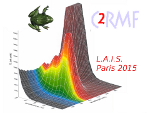Luster ceramics is an invention of Iraq Islamic potters dating back to the 9th century AD to decorate glazed ceramics. The main feature of this decoration is a very thin layer of Ag and/or Cu nanoparticles diffused inside the glaze some tens or hundreds of nm below its surface. An important issue when analyzing the technology of these artifacts is the determination of the composition, extend, size and concentration of the metallic nanoparticles forming the luster layer. In this work we report on the complementary use of the analytical techniques ionoluminescence (IL), elastic backscattering (EBS) and focused ion beam-scanning electron microscopy (FIB-SEM) to characterize IX -XVIII AD Islamic luster ceramic samples and to gain insight on the effect of the luster on the emitted IL spectra.
A set of 24 shreds of luster Islamic ceramics were supplied by the Ashmolean museum. Simultaneous EBS and IL was performed with the 5 MV CMAM's tandem accelerator using a He beam of 3070 keV. IL spectra were recorded with an OCEAN spectrophotometer. A fragment in many of the samples was taken and prepared for FIB-SEM analysis at Center for Research in Nano-Engineering from UPC. EBS is a suitable technique for the study of the luster layer as it can provide quantitative determination of the concentration profiles of the elements Ag and Cu composing the nanoparticles. The information on the composition profile obtained from EBS was compared to the FIB-SEM images. Both results showed an excellent agreement, confirming the suitability of EBS for these studies. In many cases the glaze covering the ceramic may show luminescence induced by the analyzing ion beam, in our case He ions. The spectral composition of the light emitted may depend, among other things, on the chemical environment of the glaze, on the filtering effect of the nanoparticles forming the luster layer as well as on the damage produced by the probing He ion beam.
Relating the ionoluminescence to the composition of the glaze covering the ceramic, we have found, mainly, two different light emission spectra, depending on if the glaze contained or not lead oxide. The main conclusion regarding IL are:
IL from the glaze is mainly due to SiO2, showing a main emission band at 540-550 nm (2.3 eV).
The presence of lead oxide in the glaze, either originally or formed during the luster process, enhances IL emission bands at around 450 nm (2.8 eV) and around 680 nm (1.8 eV).
The presence of copper oxide in the glaze enhances IL emission bands at around 600 nm (2.1 eV).
Silver nanoparticles from the luster layer absorb, probably via surface plasmon excitation, the emission band at 450 nm.
No especial changes of the IL emission has been observed for the Cu nanoparticles luster layer.
It has been observed that the emitted luminescence may change with time, that is with increasing the irradiation dose. The general tendency for the band at around 540 nm is the peak to decrease with increasing irradiation dose. For the specific case of the peak around 680 nm in the case of a glaze containing lead oxide, and in the luster region with Ag nanoparticles, this peak exceptionally increases with irradiation dose.

 PDF version
PDF version
